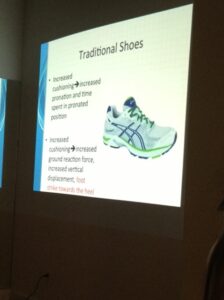Last week I attended a free seminar at Sitka Physio & Wellness in Vancouver, BC, about how to avoid runner’s injuries with a focus on the mechanics of minimalist running. We also blogged about offering seminars like this as a best practice.
Last week I attended a free seminar at Sitka Physio & Wellness in Vancouver, BC, about how to avoid runner’s injuries with a focus on the mechanics of minimalist running. We also blogged about offering seminars like this as a best practice.
Physical Therapist Elisabeth Mclatchie. Source Sitka Physio & Wellness
The seminar by physical therapist Elizabeth McLatchie, started with an overview of why people get injured: repeated mechanical stress to tissues. She then talked about how the main goal of minimalist running and the new minimalist or barefoot shoes is to change the mechanics to avoid injury. I’ve read a lot about minimalist shoes and have talked to a few runners about them, but this clinic really helped me understand what they are trying to accomplish and why: more efficient movement, and encouraging a mid-foot strike rather than a heel strike, with the long-term goal of avoiding injury.
When a runner heel strikes, his or her center of gravity is off, resulting in more force on the body and more energy spent. Heel striking also affects cadence (how quickly you can move from one foot to another) because you are spending more time transferring weight across the foot, rather than touching down and lifting off. While minimalist shoes attempt to change the way people run, people can be trained to run differently in any type of shoe. 90% of runners will heel strike in traditional shoes. Unfortunately there’s a group of about 10% of runners that will heel strike regardless of shoe. Heel striking and overuse are key causes of injuries, and over 80% of runners will be injured during their running careers.
As an example, we were shown video of a runner who regularly runs 50K races running in shoes, barefoot, and at different cadences. Running barefoot (on a treadmill) helped her to increase her cadence to 180 beats with minimal effort. For more effective running, runners should strive to be light on their feet and run at a 180 cadence. (Note that this may take some working up to: recommendations for switching to a minimalist style and shoes suggest 9-12 months for the full transition.)
Elisabeth recommended a phased approach to switching to a minimalist style, and for those wanting to try barefoot shoes, to phase in the change over 9-12 months. She also stressed that you don’t necessarily need to move to minimalist shoes to change running styles, and that there are many types of shoes. Minimalist doesn’t equal no support and no padding, it just means less rise in the heel of the shoe. For those who had further questions, she recommended talking to either an expert at a dedicated running store or a physical therapist, who could also perform a gait analysis. Elizabeth finished off the talk by demonstrating some ABCD drills, which are recommended ‘active stretch’ warm-ups for runners and talked about the lack of consensus on stretching in general.
The most important takeaways from the talk were about how to avoid overuse injuries:
- Avoid repeated mechanical stress: you can do this by varying terrain, speed, intensity, and distance
- Improve efficiency: change your running style to mid-foot strike from heel strike
- Find your cadence: running at 180 cadence and being light on feet will minimize reaction force from the ground and therefore energy loss.
Elizabeth was an engaging and enthusiastic speaker who truly cared about imparting her knowledge. Her passion for her profession shone through in the presentation.
For more on the topic of ‘barefoot’ or minimalist running:
